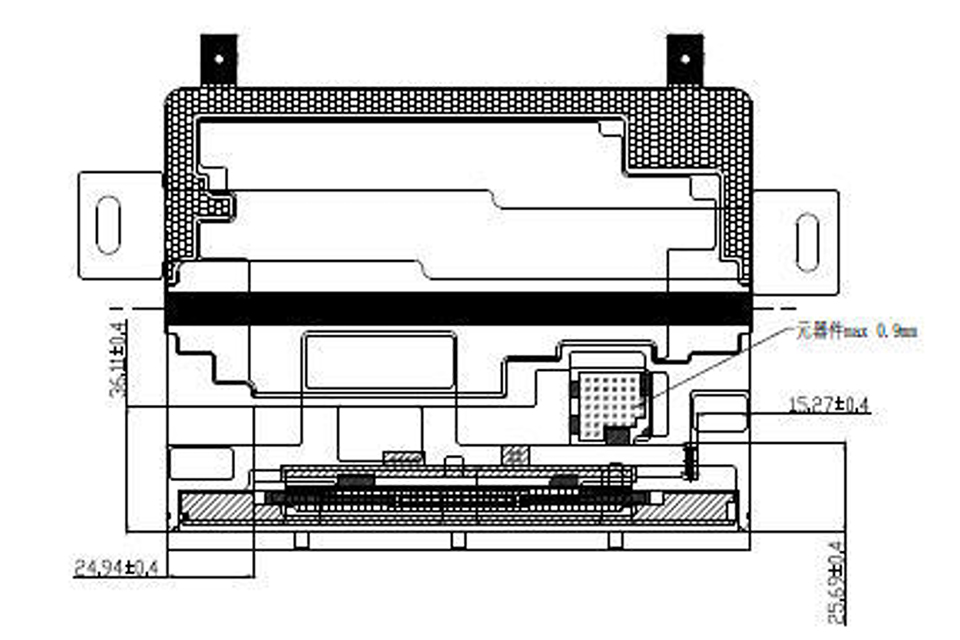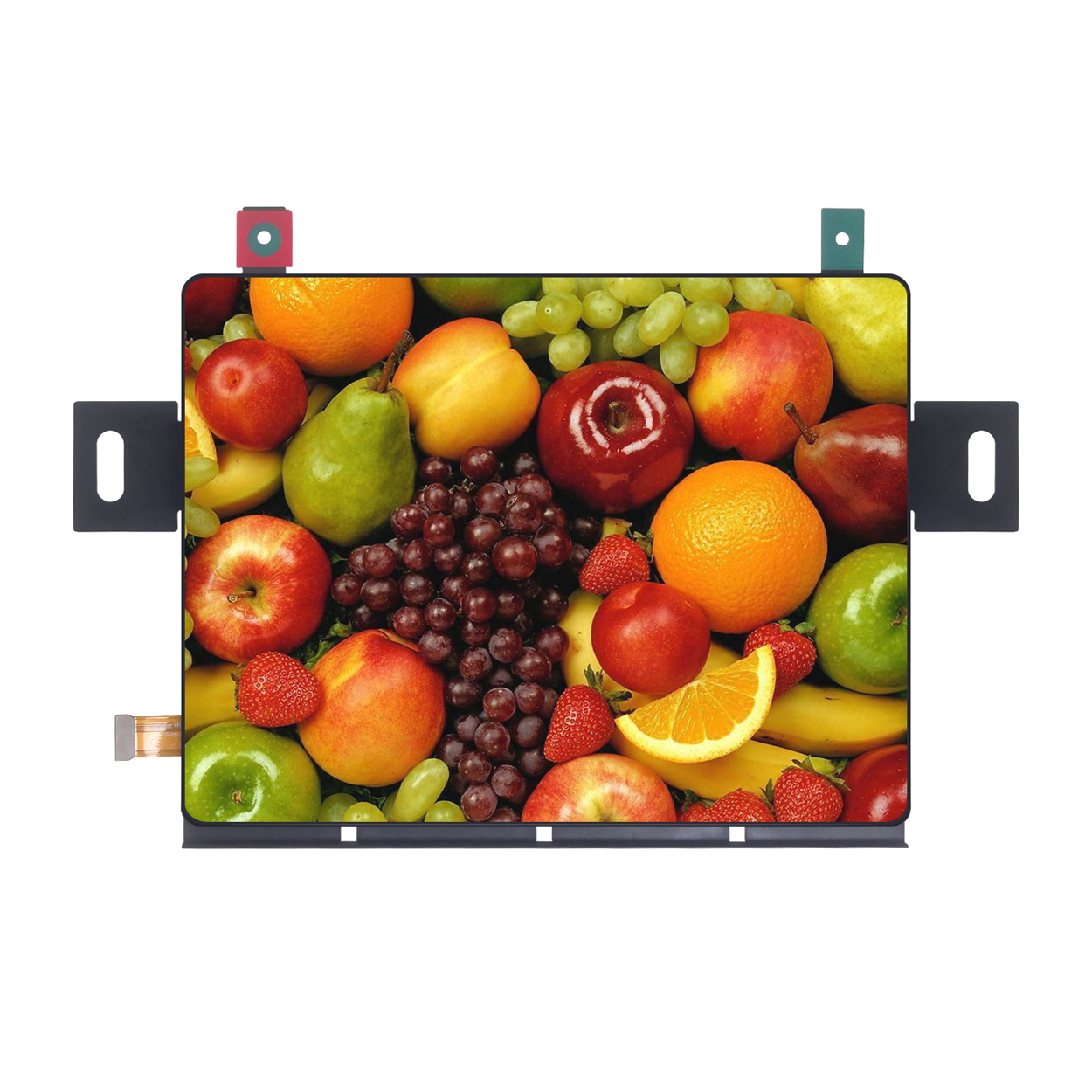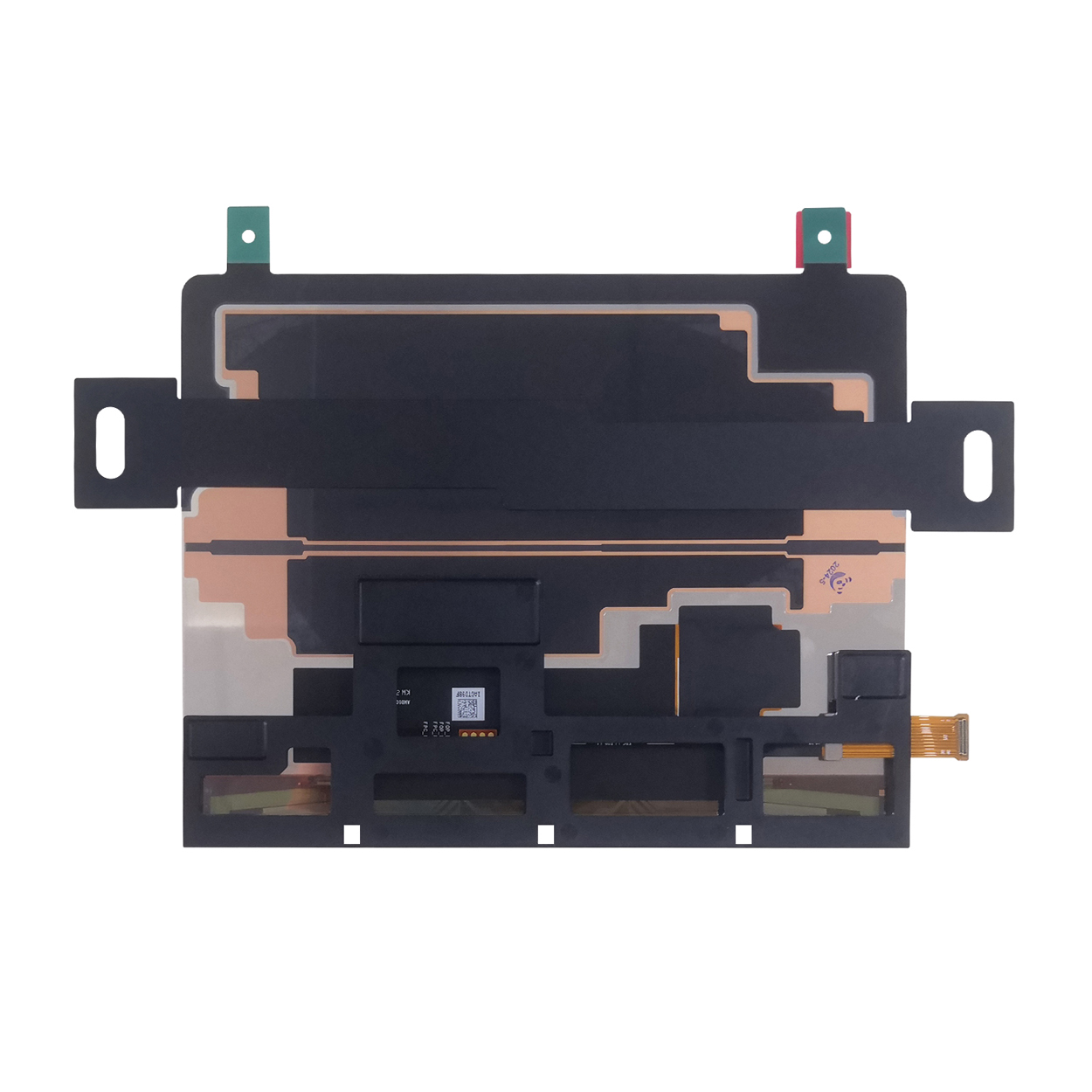
8″ Flexibel paneel AMOLED-scherm 2K OLED-scherm 2480×1860
Overzicht van flexibele AMOLED-schermtechnologie: 2K OLED-scherm
Het Flexible Panel AMOLED-scherm, met een 2K OLED-scherm met een resolutie van 2480×1860 pixels, markeert een belangrijke mijlpaal in displaytechnologie. Het 8,01-inch flexibele AMOLED-scherm combineert een hoge resolutie, een beeldverhouding van 4:3 en een aandrijffrequentie van 60 Hz, en biedt superieure prestaties voor moderne toepassingen. Het ondersteunt groene ontwerpprincipes, met de nadruk op energie-efficiëntie en duurzaamheid. Met geavanceerde componenten zoals de RM69380 driver-IC en FST1BA80YA2 touch-IC blinkt dit scherm uit in zowel visuele helderheid als responsiviteit. De toevoeging van een HDMI-driverbord verbetert de connectiviteit verder, waardoor bredere compatibiliteit tussen apparaten mogelijk is.
Gedetailleerde specificaties van het flexibele AMOLED-scherm
Het flexibele AMOLED-scherm biedt een geavanceerde combinatie van prestaties en ontwerpflexibiliteit. Hieronder staan de belangrijkste specificaties die de technische bekwaamheid van dit scherm definiëren:
| Specificatie | Details |
|---|---|
| Schermgrootte | 8,01 inch |
| Oplossing | 2480×1860 (SPR-formaat) |
| Weergavemodus | AMOLED |
| Beeldverhouding | 4:3 |
| Actief gebied | 162,688 mm × 122,016 mm |
| Omtrek afmetingen | 165,89 mm × 126,12 mm |
| Stuurprogramma IC | Prijs: €69380 |
| Raak IC aan | FST1BA80YA2 |
| IC-locatie | Stuurprogramma-IC: COP / Touch-IC: FPC |
| Aanraaksensor | PUNT |
| Interface | Aandrijving: MIPI / Aanraking: SPI |
| Bestuurdersbord | Met HDMI-bord |
| Rijfrequentie | 60Hz |
Ontwerp en functionaliteit
De AMOLED (Active Matrix Organic Light Emitting Diode) technologie die in dit flexibele display wordt gebruikt, zorgt voor levendige kleuren en diepe contrasten. AMOLED displays staan bekend om hun vermogen om echte zwarttinten te produceren, wat vooral gunstig is voor het verbeteren van de visuele ervaring in mobiele apparaten en wearables.
Het flexibele paneel van 8,01 inch integreert naadloos in een verscheidenheid aan toepassingen, van smartphones tot augmented reality-apparaten. De flexibiliteit ervan maakt het mogelijk om het in verschillende vormen te gieten, waardoor het bereik van mogelijke use cases in opkomende technologieën verder wordt uitgebreid.
Resolutie en beeldkwaliteit
De resolutie van 2480×1860 pixels biedt uitzonderlijke beeldhelderheid, waardoor het scherm ideaal is voor taken die fijne details vereisen, zoals grafisch ontwerp, videobewerking en gamen. De beeldverhouding van 4:3 biedt een uitgebalanceerd schermformaat, met voldoende schermruimte zonder dat dit ten koste gaat van de draagbaarheid.
De combinatie van een verversingssnelheid van 60 Hz en AMOLED-technologie zorgt voor vloeiende overgangen en bewegingen op het scherm, wat vooral belangrijk is bij dynamische content zoals video's en games.
Efficiëntie en duurzaamheid
Met de nadruk op groen design verbruikt dit AMOLED-paneel minder stroom vergeleken met traditionele LCD-schermen, waardoor het energiezuiniger en milieuvriendelijker is. De integratie van geavanceerde aandrijf-IC's optimaliseert het stroomverbruik verder, verlengt de batterijduur in mobiele apparaten en verkleint tegelijkertijd de algehele CO2-voetafdruk.
Geavanceerde IC en connectiviteit
Het gebruik van de RM69380 driver IC en de FST1BA80YA2 touch IC verbetert de responsiviteit van het display. De interfaceconfiguratie omvat MIPI (Mobile Industry Processor Interface) voor het aandrijfsysteem en SPI (Serial Peripheral Interface) voor touch sensing, wat ervoor zorgt dat het display nauwkeurig reageert op gebruikersinvoer.
De toevoeging van een HDMI driver board vergroot de veelzijdigheid van dit display, waardoor het kan worden aangesloten op een breder scala aan apparaten. Dit maakt het flexibele AMOLED display een uitstekende keuze voor toepassingen die high-definition output vereisen.
Conclusie
Het 8,01-inch flexibele AMOLED-paneel met een resolutie van 2480×1860 biedt een hoogwaardige displayoplossing voor een verscheidenheid aan moderne toepassingen. Het combineert geavanceerde AMOLED-technologie met geavanceerde driver- en touch-IC's, waardoor het een ideale keuze is voor apparaten die superieure beeldkwaliteit, energie-efficiëntie en flexibiliteit vereisen. De toevoeging van HDMI-connectiviteit breidt de use cases verder uit, waardoor naadloze integratie met een breed scala aan elektronische apparaten mogelijk is. Naarmate de displaytechnologie zich blijft ontwikkelen, is dit flexibele AMOLED-paneel een schoolvoorbeeld van innovatie en duurzaamheid in de tech-industrie.
Tekening


Pinbeschrijving
| Pin nr. | Symbool | IO | Beschrijving |
|---|---|---|---|
| 1 | AVDD | P | Voedingsingang voor analoog circuit |
| 2 | ELVSS | P | AMOLED negatieve voeding |
| 3 | NC1 | – | – Niet verbonden |
| 4 | ELVSS | P | AMOLED negatieve voeding |
| 5 | VCI | P | Voedingsingang voor analoog circuit |
| 6 | ELVSS | P | AMOLED negatieve voeding |
| 7 | NC2 | – | – Niet verbonden |
| 8 | NC3 | – | – Niet verbonden |
| 9 | IOVCC | P | Voedingsingang voor digitaal circuit |
| 10 | GND | P | Grond |
| 11 | VPP | P | -Niet aangesloten of aangesloten op GND indien niet gebruikt |
| 12 | NC4 | – | -Niet verbonden |
| 13 | MIPI_D2P | I | DSI-D2 Positieve Differentiële Datasignalen van MIPI |
| 14 | AVDD_NL | O | AVDD_EN Signaal voor PMIC |
| 15 | MIPI_D2N | I | DSI-D2 Negatieve Differentiële Datasignalen van MIPI |
| 16 | ZWAAR | O | -Swire-signaal voor PMIC |
| 17 | GND | P | Grond |
| 18 | RESET | I | RESET VOOR DIC |
| 19 | MIPI_D1P | I | DSI-D1 Positieve Differentiële Datasignalen van MIPI |
| 20 | ESD_VLAG | O | Foutvlag voor detectie IC-status |
| 21 | MIPI_D1N | I | DSI-D1 Negatieve Differentiële Datasignalen van MIPI |
| 22 | TE | I | DIC TE-signaal |
| 23 | GND | P | Grond |
| 24 | identiteitsbewijs | I | Hardwaredetectie-ID |
| 25 | MIPI_CLKP | I | DSI-CLK Positieve Differentiële Datasignalen van MIPI |
| 26 | TP_RST | I | Raak Reset Pin aan |
| 27 | MIPI_CLKN | I | DSI-CLK Negatieve Differentiële Datasignalen van MIPI |
| 28 | TP_SPI_MOSI | I | Touch SPI-interface, datapin |
| 29 | GND | P | Grond |
| 30 | TP_SPI_MISO | IO | Touch SPI-interface, datapin |
| 31 | MIPI_D0P | IO | DSI-D0 Positieve Differentiële Datasignalen van MIPI |
| 32 | TP_SPI_CS | IO | Touch SPI-interface, chipselectie |
| 33 | MIPI_D0N | IO | DSI-D0 Negatieve Differentiële Datasignalen van MIPI |
| 34 | TP_SPI_SCK | IO | Touch SPI-interface, klokpen |
| 35 | GND | P | Grond |
| 36 | TP_INT | IO | TP-onderbreking |
| 37 | MIPI_D3P | I | DSI-D3 Positieve Differentiële Datasignalen van MIPI |
| 38 | TP_1V8 | P | Voedingsingang voor TP digitaal circuit |
| 39 | MIPI_D3N | I | DSI-D3 Negatieve Differentiële Datasignalen van MIPI |
| 40 | TP_3V3 | P | Voedingsingang voor TP analoog circuit |
| 41 | ELVDD | P | AMOLED Positieve Voeding |
| 42 | ELVDD | P | AMOLED Positieve Voeding |
| 43 | ELVDD | P | AMOLED Positieve Voeding |
| 44-45 | GND | P | Grond |
| 46 | GND | P | Grond |
Waarom voor ons kiezen
Kennisbank
Technologie ontwikkelt zich in een ongelooflijk tempo en om voorop te blijven lopen, is voortdurend leren en een open-minded benadering nodig. Door onze kennis voortdurend uit te breiden, zorgen we ervoor dat we leiders blijven in ons vakgebied.
Ga met ons mee en ontdek de nieuwste trends en inzichten. Grijp de kans om uw kennis van LCD-technologie op te frissen en te verdiepen!


Onze kernwaarden en missie
Wij streven ernaar de toonaangevende leverancier van LCD-oplossingen te zijn door hoogwaardige producten, uitzonderlijke klantenservice en het bevorderen van op vertrouwen gebaseerde relaties te leveren. Wanneer u met ons werkt, bent u niet alleen een klant - u wordt onderdeel van onze familie.
Uw behoeften zijn onze prioriteit en wij streven ernaar om u bij elke stap van de reis succesvol te maken.
Ons productaanbod
Of het nu gaat om onze standaardaanbiedingen of een oplossing op maat, kwaliteit is altijd onze topprioriteit. We optimaliseren onze processen voortdurend om de beste combinatie van concurrerende prijzen en tijdige levering te leveren. Ons doel is om uitzonderlijke waarde te bieden en tegelijkertijd aan uw specifieke behoeften te voldoen.
Ontdek vandaag nog ons productassortiment en ontdek hoe wij u kunnen helpen met uw volgende project!


Wereldwijde klantenondersteuning
Wij zijn een full-service LCD-oplossingenfabrikant en -leverancier, gespecialiseerd in een breed scala aan elektronische producten. Onze expertise omvat kleuren-TFT-schermen, embedded LCD's, touchpanels, LCD-verwarmers, backlights en zowel karakter- als grafische LCD's.
Wij bieden uitgebreide oplossingen die voldoen aan de behoeften van uiteenlopende sectoren. Ontdek samen met ons de nieuwste trends en inzichten.
Veelgestelde vragen
Het flexibele AMOLED-scherm heeft een resolutie van 2480×1860 pixels (SPR).
Het schermformaat van het flexibele AMOLED-scherm is 8,01 inch.
Dit paneel maakt gebruik van AMOLED-technologie (Active Matrix Organic Light Emitting Diode), die zorgt voor levendige kleuren en diepe zwarttinten.
De beeldverhouding van het flexibele AMOLED-scherm is 4:3.
Het flexibele AMOLED-scherm heeft een groen ontwerp dat minder stroom verbruikt dan traditionele LCD-schermen, waardoor het energiezuiniger en milieuvriendelijker is.
Het flexibele AMOLED-scherm ondersteunt een aandrijffrequentie van 60 Hz.
Het display maakt gebruik van de RM69380 driver-IC en de FST1BA80YA2 touch-IC voor verbeterde prestaties en responsiviteit.
Het display maakt gebruik van MIPI (Mobile Industry Processor Interface) voor het aandrijfsysteem en SPI (Serial Peripheral Interface) voor aanraakdetectie.
Ja, het scherm beschikt over een driverbord met HDMI-aansluiting, waardoor u het op een breder scala aan apparaten kunt aansluiten.
Het flexibele AMOLED-scherm biedt een hoge resolutie, energie-efficiëntie, superieure beeldkwaliteit en een flexibel ontwerp. Hierdoor is het ideaal voor toepassingen in mobiele apparaten, wearables en opkomende technologieën.









